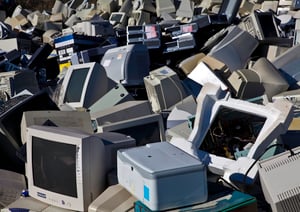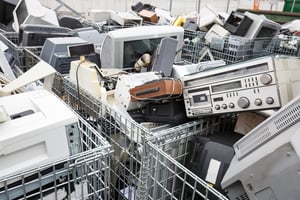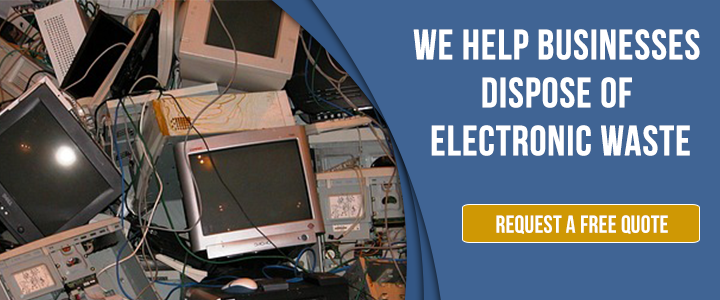Do you remember your first computer? That sleek machine with the latest operating system that could take on any task you threw at it?
Fast forward a few years and that same computer may now be outdated, slow and taking up valuable space. But what happens when you finally decide to get rid of it and replace it with a new updated computer?
If your answer is to toss it in the trash and forget about it, you may be contributing to a growing problem … electronic waste. Now imagine you’re in charge of upgrading your entire network of computers at your place of employment. After all, the latest technology can enhance productivity, streamline operations and improve collaboration among team members.
But now you’ve got a real electronic waste problem on your hands, and potentially are opening yourself up to having a devastating impact on the environment. That’s just the tip of the iceberg as well. You may face legal problems for violating environmental regulations if you dispose of these unwanted electronics improperly by dumping them in your trash rather than properly recycling them.
Here’s what can happen if you toss electronic devices you no longer want into the dumpster and what the better alternative is for both the environment and your business.
The Problem: Discarding Computers In Landfills
The process of discarding computers in landfills is an issue that has gained significant attention in recent years. With the rapid advancement of technology, computers and other electronic devices are becoming obsolete at a faster rate, leading to an increase in electronic waste.
the rapid advancement of technology, computers and other electronic devices are becoming obsolete at a faster rate, leading to an increase in electronic waste.
Electronic waste, also known as e-waste, is a term used to describe discarded electronic devices that are no longer useful or wanted. The volume of e-waste is staggering, with estimates suggesting that around 50 million metric tons of e-waste are produced annually worldwide.
Within computers are multiple examples of e-waste, from circuit boards to CRT monitors. Each is constructed using toxic materials and heavy metals that can become problematic for soil, the water supply and human health when discarded in landfills.
And with an estimated 300 million computers in production annually, it’s inevitable that even more computers will be headed for the landfill, which can have severe environmental consequences.
Environmental Impact Of Discarding Computers In Landfills
It can be tempting … even easy … to simply toss any computers that are no longer needed or usable from your worksite into the trash receptacles out back. Ultimately, these old electronics will end up in landfills that every year are filled with 139.6 million tons of waste. What harm could a few more computers do? A lot.
So how does discarding computers in a landfill affect the environment? When computers are discarded in landfills, they can release toxic chemicals into the environment. This is because computers contain various hazardous substances like lead, cadmium and mercury, which can leach into the soil and groundwater.
This can have serious health implications for both humans and wildlife since exposure to these chemicals can cause a range of illnesses, including cancer and birth defects.
In addition to the potential health risks, discarding computers in landfills can also contribute to air pollution. When e-waste is burned or incinerated, it can release harmful chemicals and gasses into the atmosphere, including dioxins and furans, which are highly toxic.
How Improper Disposal Can Impact Your Business
Although discarding computers in a landfill can affect the environment and human health, it’s important for businesses to also keep in mind that this act can impact the future of their companies.
to also keep in mind that this act can impact the future of their companies.
California e-waste laws are among some of the most strict in the United States. It is illegal to throw away several types of e-waste, including computers. Other types of e-waste commonly found in office settings include cell phones, fax machines, copiers, stereos, batteries, old televisions and more. In manufacturing, hospital and industrial settings, additional types of electronic waste include lab equipment, servers, laptops and tablets.
This disposal of cathode ray tubes (CRTs) is also regulated in California. CRTs are found in computer monitors and are one of the newer types of e-waste classified as hazardous waste at the federal level by the Resource Conservation and Recovery Act (RCRA).
If your business doesn’t follow these laws, you’ll likely see several negative impacts, from legal consequences to a bruised public image. Retail giant Target was fined $7.4 million for illegally dumping more than 2,000 items of hazardous e-waste between 2012 and 2016. Authorities said these items should have been properly recycled.
Improper e-waste disposal can also harm a company’s reputation. With increasing awareness of the environmental impact of e-waste, consumers are becoming more conscious of the environmental practices of businesses. If a company is seen to be disregarding the environment by discarding its electronic devices in landfills or incinerators, this can damage its reputation and lead to a loss of customers.
Improper e-waste disposal can even have a negative impact on employee morale. Many employees are passionate about environmental issues and may become disheartened if they perceive that their employer is not taking these issues seriously. This can lead to decreased productivity, increased turnover and difficulty in attracting new talent.
There also may be missed opportunities for businesses that fail to dispose of their electronic devices responsibly. For example, e-waste recycling programs can offer businesses the opportunity to recover valuable materials, reduce costs and enhance their environmental credentials. By failing to participate in programs like these, businesses may miss out on these benefits.
How To Dispose Of Computers Safely
While there are electronics recycling facilities available throughout the state, if you have a large number of computers that need to be properly recycled, it may be best to partner with an experienced e-waste disposal company.
Electronic waste disposal companies can provide your business with the services it needs to safely and responsibly dispose of not only computers, but any e-waste you generate. As a business that generates waste, you are responsible for it from the moment it is generated until it is legally disposed of. This is known as cradle to grave.
Many businesses may find it difficult to determine which drop-off facilities will accept their e-waste. You also may have to worry about employees who say they are transporting this waste to the appropriate facilities but end up making a pit stop at a trash receptacle instead.
The best e-waste disposal companies will ensure that the waste is properly recycled or disposed of AND provide proof this occurred. And even if you’re convinced your employees are responsible and trustworthy, it’s quite a task to determine which facilities accept which types of waste. While one may accept computer monitors, it may not accept power cords or motherboards. If you have other types of electronic waste to drop off, your employees may find themselves driving all over Southern California to match the facility with the waste it accepts.
Quantities could be another issue you face. While drop-off facilities may accept the various computer parts you have that need to be recycled, they may only accept a certain quantity of those items. One computer is very different from 200 computers, and it’s common for companies, schools and medical facilities to swap out all of their computers at once when upgrading their equipment.
Electronic waste disposal companies can help you save valuable time with this process. If your business regularly generates e-waste or you are undergoing facilities upgrades, a waste disposal company that is experienced in handling e-waste can ensure the safe disposal of electronic waste and the protection of your company’s reputation.


Comment